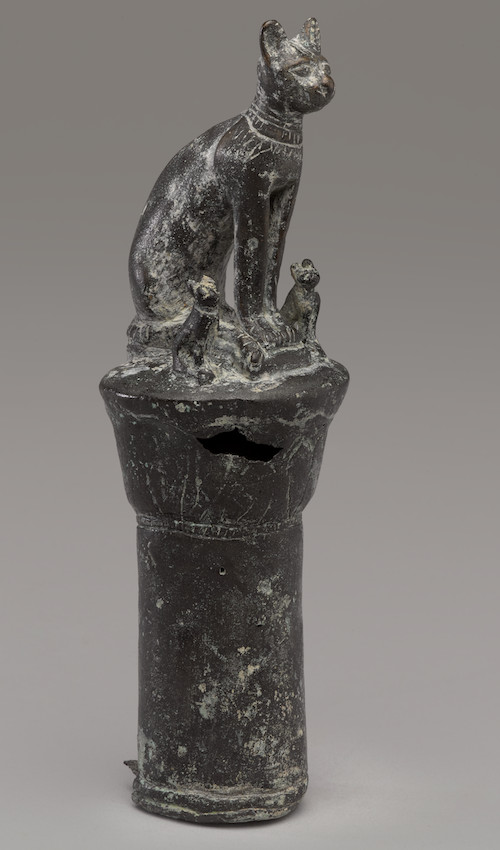Cats, Bastet and the Worship of Feline Gods
Cats are among the most iconic animals in ancient Egyptian art and culture. The Egyptians encountered lions, panthers and jungle cats in the wild. Smaller cats lived among humans from early on, hunting vermin in homes and granaries. Through close observation, the Egyptians came to admire felines for their complex, dual nature. Felines combine grace, fecundity and gentle care with aggression, swiftness and danger. Gods ascribed with these qualities were often represented with feline features. But Egyptians did not worship felines. Rather, they believed these ‘feline’ deities shared certain character traits with the animals.
Bastet is probably the best-known feline goddess from Egypt. Initially depicted as a lioness, Bastet assumed the image of a cat or a feline-headed woman in the 2nd millennium BCE. Although she combined both nurturing and violent qualities, her shielding and motherly aspects typically were emphasized. Countless representations of a seated cat, cat-headed goddess or cat with kittens include dedicatory inscriptions addressed to Bastet. By offering such inscribed images, donors expressed their wishes for health and children or, more generally, life and protection.
Such revelations were important to an exhibition I organized at the Brooklyn Museum, called Divine Felines: Cats of Ancient Egypt. The idea for this show began while I was exploring our storerooms. A gilded wooden statuette of a goddess with a leonine head and the body of a woman peered at me from a shelf and stopped me in my tracks. I was intrigued by its beauty and elegance and by the unusual combination of her features. She has been in Brooklyn since 1937 but remained off view because of her poor condition.
This goddess with a feline head and leonine ears wears a tripartite wig. Judging by the remains of a peg on top of the head, a separately made sun-disk once adorned her, holding the bronze uraeus in place. She sits on a floral base with both her feet and buttocks touching the floor and knees drawn up to the torso. Her feet appear tightly bound together, connecting her to the underworld as if on a mummy. Her arms are bent at the elbows, with the right hand clenched in a fist while the left palm extends beside her left knee. The black painted base, reminiscent of a papyrus umbel, has an opening on the stem-end. Unexpectedly, a small cat mummy was originally enclosed in the hollow interior of the figure. But why was it there? To whom was it offered?
Although the Brooklyn statuette incorporates features familiar from Egyptian art, the compilation of these features makes it very unusual and, at first consideration, mysterious. For example, our goddess’ crouching or squatting position is used in two-dimensional representations of gods that appear in temples or tombs and on mortuary papyri. However, in three dimensions lion-headed female divinities are usually standing, striding or seated on a throne. Next, the umbel base of our figure recalls papyrus scepters frequently held by feline divinities and papyrus-form columns with cats on top dedicated to Bastet. Still, floral-shaped bases are unusual for wooden figures of gods of this size (just over a foot in height), and rarely appear as an animal mummy container. Such bases are more common in smaller bronzes and amulets or in large stone sculpture. Finally, containers for cat mummies do not typically take the form of a crouching feline goddess. Instead, animal mummy containers in the shape of a lion-headed woman generally represented the goddess seated on a throne and inscribed as Wadjet. And the Wadjet container, usually was for ichneumons (mongeese), not cats.
Despite the unusual features, certain details are clues to the identity of our statuette. Many powerful goddesses were represented with her features, although they are notoriously difficult to identify without an inscription. Bastet, Sakhmet, Mut, Tefnut, Shesemtet, Pakhet, Mafdet, Wadjet and others all appeared as a lioness or lion-headed woman with a sun disk on her head. Each one was named a daughter of the Sun God and the Eye of the Sun. Egyptians associated cats with the sun for a number of reasons. They saw the red and yellow fur of cats and lions as the colors of the sun itself. Cats love warmth and basking in the sun. And most importantly, much like the self-contradictory nature of felines, the sun possesses a dual nature as a warming source of life or a scorching danger in the desert. Thus, many dangerous and protective daughters of the sun god were endowed with a leonine nature.
In Egyptian mythology, the terrifying and nurturing aspects of feline goddesses are most commonly represented by the Sekhmet and Bastet, with other daughters of the Sun worthy of this title. For instance, Hathor-Tefnut is described in the Myth of the Eye of the Sun in Philae as the one who “rages like Sekhmet and is friendly like Bastet.” All these goddesses should be seen as one fierce, feline, female force that carried the power of the sun’s fire to destroy, burn and scratch all who stood in her way, but turned into a motherly divinity when pacified.
The mummy found inside the Brooklyn figurine – indeed a cat mummy – offers a clue to the figurine’s function. Cats are one of the more numerous animals to be mummified by the ancient Egyptians. Each mummified animal was linked to a specific god and offered to that god in hopes of favor or a sign of gratitude. Egyptians dedicated cat mummies to the nurturing and dangerous goddess Bastet. Bubastis, the Delta city that was the center of worship of this goddess, is the origin of masses of cat mummies. Most of these were placed in rectangular or cat-shaped coffins or wrapped in linen and painted to resemble a cat. Mystery solved, as much as any ancient Egyptian puzzle can be: the Brooklyn Museum’s figurine served as a particularly fancy cat mummy container, probably an attempt to conjure extra favor from Bastet.


